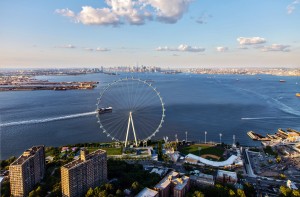
Conceptual rendering of the North site view of the New York Wheel and New York Harbor. Image credit: NYCEDC
The modifications would alter the parking garage, restaurant, and other amenities. On October 22, 2015, the City Council Committee on Land Use unanimously approved New York Wheel LLC’s application to modify the previously-approved special permit for the construction of the New York Wheel, located on the St. George Waterfront in Staten Island. The New York Wheel originally succeeded through the Uniform Land Use Review Procedure process in 2013, but is now seeking approval for a redesigned parking garage and several other modifications.
After the New York Wheel’s initial ULURP application passed through the City Council, site analyses revealed that the soil below the original parking facility is not stable enough to support the foundation. In response, several modifications have been made to the construction plan, including a thinner and taller parking garage.
On October 20, 2015, the City Council Subcommittee on Zoning and Franchises held a public hearing on the New York Wheel LLC’s application. Council member Deborah Rose, who represents the 49th Council District in which the NY Wheel would be located, opened the hearing with a statement of her approval of the project and the impact it would have on Council District 49 and Staten Island as a whole. “All of the points of agreement that I fought for in 2013’s ULURP are positively reflected in these changes,” stated Ms. Rose.
Rich Marin, president and CEO of New York Wheel LLC, explained that site analyses had been conducted prior to New York Wheel’s original application submission. The Department of Buildings, however, updated its Building Code in 2014, which now requires heightened standards for buildings constructed in “areas subject to liquefaction,” said Marin, “which is a seismic condition” that causes the soil to become unreliably malleable. Marin testified that a portion of the original parking garage would have sat upon soil affected by liquefaction. The proposed changes provide a condensed garage with an additional floor level to provide the 950 parking spaces planned in the original blueprints. Marin testified further that because the size of the building terminal also had to be reduced, the “white tablecloth restaurant” has been replaced with an “open air, al fresco beer garden.”
Subcommittee Chair Donovan Richards asked several questions about the jobs that would be created by the project and the percentage of contracts that would be afforded to local businesses and MWBEs. Marin testified that the developers have set a goal of hiring 25% locally and 25% MWBE. Subcommittee Chair Richards responded, “I think you can do better than that.” By request, Marin committed to creating a task force in cooperation with Ms. Rose to ensure there is adequate opportunity for local residents to seek employment. Tom McKnight, executive vice president and head of planning, development, and transportation at NYCEDC, testified that the developers would be participating in HireNYC and that there would be “a central location for local residents who are interested in job opportunities.”
Ms. Rose inquired about the “open air ventilation system” that would be used in the parking garage and the impact it would have environmentally, especially due to its close proximity to a playground. Peter Liebowitz, senior vice president at AKRF—an environmental consulting firm—testified that the design had been modeled with the playground in mind, and it provides for a widespread disbursement of the emissions that would not have an adverse impact upon playground visitors.
Michael Harwood, local St. George resident and representative of St. George Civic Association, testified in opposition to the project. He alleged that the St. George Civic Association originally supported the project based on promises made by the developers of a fully enclosed parking garage, upscale retail stores, and other amenities that have since been removed from the blueprints. “The changes to this project are a substantial change to the tenor of our neighborhood. The promises that have been made in the past have not been kept,” Harwood testified, “and we have no reason to think they will be kept in the future.”
The modifications were approved by Staten Island Community Board 1 on July 21, 2015 and by the City Planning Commission on October 7, 2015. The Zoning and Franchises Subcommittee unanimously approved the application at the October 20th hearing. The full City Council will vote on the application at its stated meeting on October 28, 2015.
City Council: LU 0288-2015 (Oct. 22, 2015).
UPDATE: On October 29, 2015, the City Council unanimously voted at its stated meeting to approve the proposed New York Wheel modifications.
By: Jessica Soultanian-Braunstein (Jessica is the CityLaw Fellow and a New York Law School Graduate, Class of 2015)

